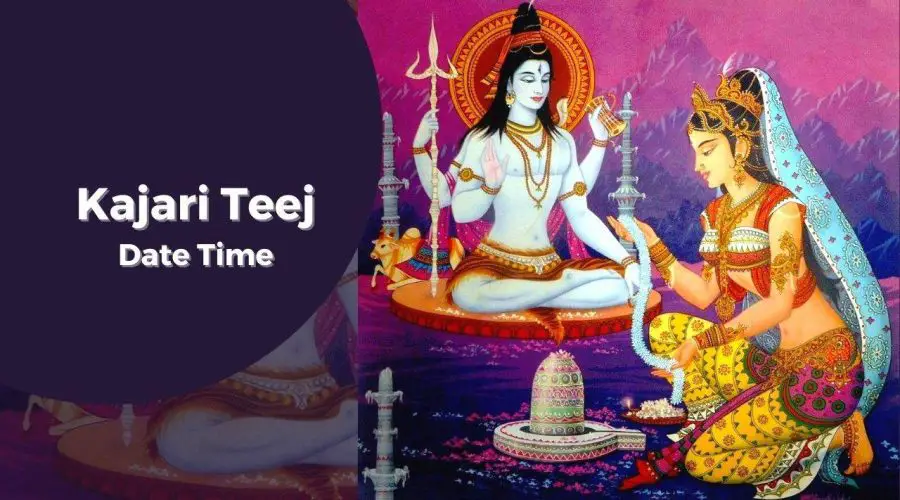Kajari Teej 2023: Date, Time, Rituals, Puja Vidhi, and Significance
Article Rating
☆☆☆☆☆ 4/5
Kajari Teej, which is also called Kajali Teej, is a big holiday in India. This Hindu holiday is held on the third day of the dark fortnight (Krishna Paksha) in the lunar month of Bhadrapada. According to the Gregorian calendar, Kajari Teej usually happens in July or August. It is more or less a festival that is mostly enjoyed by Hindu women. Rajasthan, Madhya Pradesh, and Uttar Pradesh are the places where the event is most important.
Kajari Teej Date 2023
Saturday, 02 September 2023
Kajari Teej Rituals
Kajari Teej is celebrated with great zeal and delight on the eve of the festival. Although people in different locations put their own twist to the event, the essential rites remain the same, which include:
- Women who are on a severe Kajari Teej Fast should consume something first thing in the morning, before sunlight.
- They then abstain from eating and drinking for a period of time.
- Then, in the evening, married women dress up and worship the Neem tree and the Moon before breaking their fast.
- After starting this fast, a woman would have to keep it up for the next 16 years.
- Married ladies conduct a Kajari Teej fast for their husbands’ longevity and good fortune. This fast is also observed by unmarried girls in order to be blessed with a nice husband.
- Women worship the Moon to break the fast, and some worship the Neem tree to break the fast.
- Sattu is made from rice, gramme, wheat, and barley on this day.
- It is important to worship cows on Kajari Teej. The sacred cows must be fed first with little chapatis consisting of wheat flour, ghee, and jaggery. The worshippers are allowed to eat after this procedure.
- Hindu ladies celebrate the event by singing and dancing to traditional melodies and decorating their homes with colourful swings.
- The music are another important component of this day. Individuals from Bihar and Uttar Pradesh perform numerous Kajari Teej songs, accompanied by the soothing beats of drums.
Kajari Teej Puja Vidhi
Goddess Neemdi, also known as Neemdi Maa, is affiliated with the sacred Kajari Teej festival. On this day, worshippers worship Goddess Neemdi with zeal. Before beginning the puja, a procedure is performed that entails constructing a pond-like structure with the help of certain walls. Jaggery and pure ghee are utilised to decorate the structure’s exterior edges.
Nearby, a twig of Neem is planted. Devotees pour water and raw milk around the structure and light a lamp. Whole rice, sacred thread, vermillion, sattu, fruits, cucumber, and lemon are used to decorate the puja thali. Raw milk is kept in a vase, and devotees worship Goddess Neemdi according to the rituals stated below in the evening:
- The Goddess is offered rice, vermillion (indoor), and sprinkling water.
- The ring finger is used to make 13 dots with henna and vermillion, and the ring finger is also used to make 13 dots with kohl.
- After offering the sacred thread to the Goddess, clothing, kohl, and henna are offered.
- The sacred thread is then used to decorate the wall using the dots that have been marked on it.
- Fruits are also presented to the Goddess. Devotees wrap the sacred thread around the kalash (sacred vessel) and apply a Tilak of vermillion to it on the Puja Kalash.
- Women must examine the nosepin, neem twig, cucumber, and lemon in the light of the diya (earthen lamp) that is set beside the pond (diya). Following that, Arghya is offered to the Moon.
Significance of Kajari Teej
Kajari Teej is a Hindu women’s festival that is eagerly anticipated. It’s a lively event for them, and it’s significant since it’s linked to their marital bliss and their husband’s long life.
In some areas, the Kajari celebration is also known as Satudi Teej or Bundi Teej. This is known as Badi Teej, whereas Hariyali Teej is known as Choti Teej. This celebration, however, has a comparable meaning for married women. Fasting on Kajari Teej is thought to endow women with enormous delight and contentment in their married lives, according to Hindu traditions.

